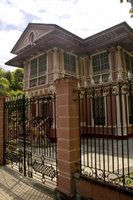 I'm not talking about bacon, lettuce and tomato. If you've heard about that bus company with the acronym BLTB Co. and know what it stands for, then you know where I was this time around. Hehe! Yup, it was another round of Batangas, Laguna and Quezon Province (Tayabas). The main destination was another heritage town which I've been wanting to visit since my trip to Sariaya, Quezon last year.It was just a few kilometers away, separated only by the town of Candelaria. Had I known during last year's Pahiyas trip what was waiting to be seen there, we would have stopped by. That town is San Juan, Batangas, another community that prospered early in the 20th Century as a result of the coconut boom. It is more known for its popular beach resorts such as La Luz. But few people realize that just like Sariaya, the town is littered with elegant pre-WWII mansions.
I'm not talking about bacon, lettuce and tomato. If you've heard about that bus company with the acronym BLTB Co. and know what it stands for, then you know where I was this time around. Hehe! Yup, it was another round of Batangas, Laguna and Quezon Province (Tayabas). The main destination was another heritage town which I've been wanting to visit since my trip to Sariaya, Quezon last year.It was just a few kilometers away, separated only by the town of Candelaria. Had I known during last year's Pahiyas trip what was waiting to be seen there, we would have stopped by. That town is San Juan, Batangas, another community that prospered early in the 20th Century as a result of the coconut boom. It is more known for its popular beach resorts such as La Luz. But few people realize that just like Sariaya, the town is littered with elegant pre-WWII mansions.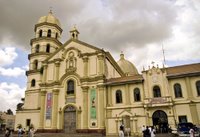 We left Manila after rush hour for what was to be a quick leisurely drive to Batangas. We were quite surprised we were in Sto. Tomas, Batangas in no time, which is the entry point of the STAR Tollway to Lipa City. I hope they make more of these roads in the provinces since passing by town poblacions is just too frustrating no thanks to the tricycles.
We left Manila after rush hour for what was to be a quick leisurely drive to Batangas. We were quite surprised we were in Sto. Tomas, Batangas in no time, which is the entry point of the STAR Tollway to Lipa City. I hope they make more of these roads in the provinces since passing by town poblacions is just too frustrating no thanks to the tricycles.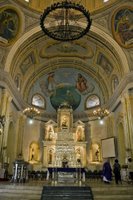 Before proceeding to San Juan, we decided to make a stopover at the San Sebastian Cathedral, the seat of the Archdiocese of Lipa. The Romanesque church was completed in 1865 but just like much, if not most of our architectural heritage, it was devastated during the war with the current cathedral a result of massive reconstruction and restoration. What attracted me to the cathedral were photos of its wall and ceiling murals. But upon entering, I was quite disappointed.At the back were paintings of the twelve apostles. But the images and poses were so Hollywood, most probably taken from Franco Zeffirelli's 1977 movie Jesus of Nazareth! Talk about taste in a heritage church! The rest of the murals were ok and thankfully not as bad as those at the back. I guess Betis, Pampanga still tops the list for the best church murals, living up to its moniker of Sistine Chapel of the Philippines.
Before proceeding to San Juan, we decided to make a stopover at the San Sebastian Cathedral, the seat of the Archdiocese of Lipa. The Romanesque church was completed in 1865 but just like much, if not most of our architectural heritage, it was devastated during the war with the current cathedral a result of massive reconstruction and restoration. What attracted me to the cathedral were photos of its wall and ceiling murals. But upon entering, I was quite disappointed.At the back were paintings of the twelve apostles. But the images and poses were so Hollywood, most probably taken from Franco Zeffirelli's 1977 movie Jesus of Nazareth! Talk about taste in a heritage church! The rest of the murals were ok and thankfully not as bad as those at the back. I guess Betis, Pampanga still tops the list for the best church murals, living up to its moniker of Sistine Chapel of the Philippines.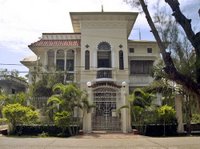
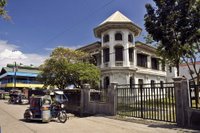 With that done, it was off to San Juan. We arrived just in time for lunch. So after a short familiarization drive around, we looked for a place to eat. And since the summer heat was getting to be unbearable, we looked for the first air-conditioned restaurant we could find. I think the place we ate at was the only one in the poblacion... hehehe!After lunch, it was time for photos. My Canon camera is still under repair (they recalled certain models due to manufacturing defects), so I'm relying on Karlo de Leon's photos for this entry. If documenting heritage were a crime, then I guess partners in crime would be an apt description since we're both heritage addicts. Hehe!
With that done, it was off to San Juan. We arrived just in time for lunch. So after a short familiarization drive around, we looked for a place to eat. And since the summer heat was getting to be unbearable, we looked for the first air-conditioned restaurant we could find. I think the place we ate at was the only one in the poblacion... hehehe!After lunch, it was time for photos. My Canon camera is still under repair (they recalled certain models due to manufacturing defects), so I'm relying on Karlo de Leon's photos for this entry. If documenting heritage were a crime, then I guess partners in crime would be an apt description since we're both heritage addicts. Hehe!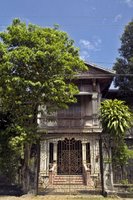
 The houses are scattered around the town. But it was obvious that the San Juan mark was fast disappearing due to modernization, possibly evolving into another nondescript Filipino town. Unlike Sariaya which has its town character quite intact, modern structures sprout like mushrooms in between heritage houses, obviously out of place. If San Juan is indeed serious in maximizing its heritage potential, it should enact a local ordinance that would regulate the scale and facades of new structures, similar to what we've done in the City of San Fernando. If we only had that much heritage in San Fernando intact! But we lost a lot in the Philippine-American War, WWII and the floods that hit Pampanga after the Mt. Pinatubo eruption. In fact, the chalets in our American quarter are half-buried after the roads were raised by at least a meter.We didn't want to go back via Lipa since traffic management there was bad. So we decided to go home via Tiaong and San Pablo City, Laguna. And since we were in the City of Seven Lakes, we decided to check out some of them.
The houses are scattered around the town. But it was obvious that the San Juan mark was fast disappearing due to modernization, possibly evolving into another nondescript Filipino town. Unlike Sariaya which has its town character quite intact, modern structures sprout like mushrooms in between heritage houses, obviously out of place. If San Juan is indeed serious in maximizing its heritage potential, it should enact a local ordinance that would regulate the scale and facades of new structures, similar to what we've done in the City of San Fernando. If we only had that much heritage in San Fernando intact! But we lost a lot in the Philippine-American War, WWII and the floods that hit Pampanga after the Mt. Pinatubo eruption. In fact, the chalets in our American quarter are half-buried after the roads were raised by at least a meter.We didn't want to go back via Lipa since traffic management there was bad. So we decided to go home via Tiaong and San Pablo City, Laguna. And since we were in the City of Seven Lakes, we decided to check out some of them.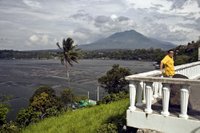 Of course, the most prominent of the lakes is Sampalok. At 104 hectares, it is the biggest of the seven lakes and located in the city proper. It was the first lake we visited. The view of Mount Banahaw as a backdrop to the lake was just awesome. But we were in the mood for adventure so we asked around how to get to the others. Since we didn't have time to visit all, we asked for the best one, regardless of distance. And according to those we asked, it was Calibato Lake in Barangay Sto. Angel, which was at the boundary with the town of Rizal, Laguna.
Of course, the most prominent of the lakes is Sampalok. At 104 hectares, it is the biggest of the seven lakes and located in the city proper. It was the first lake we visited. The view of Mount Banahaw as a backdrop to the lake was just awesome. But we were in the mood for adventure so we asked around how to get to the others. Since we didn't have time to visit all, we asked for the best one, regardless of distance. And according to those we asked, it was Calibato Lake in Barangay Sto. Angel, which was at the boundary with the town of Rizal, Laguna.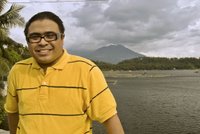 On the way they, we passed by Palakpakin Lake in Barangay San Buenaventura. It has an area of 43 hectares, and looks similar to Sampalok. This time, there were lesser signs of progress and thus, a better view of Banahaw. We took shots from a bridge and moved on to our final destination, Calibato.
On the way they, we passed by Palakpakin Lake in Barangay San Buenaventura. It has an area of 43 hectares, and looks similar to Sampalok. This time, there were lesser signs of progress and thus, a better view of Banahaw. We took shots from a bridge and moved on to our final destination, Calibato. It was difficult looking for Calibato since it was not along the road and you had to hike a bit to get there. After asking around, we finally found the point from where to start the hike down to the 42-hectare crater lake. We didn't know what to expect or how far the lake was from where we parked. Just looking at the downward steps made us imagine the effort it would entail to get back up. Pant! Pant! Hehe! But as we neared the lake, the narrow canyon carved by the small stream increased the level of excitement. I hope we are able to preserve what is left of nature here in the county.
It was difficult looking for Calibato since it was not along the road and you had to hike a bit to get there. After asking around, we finally found the point from where to start the hike down to the 42-hectare crater lake. We didn't know what to expect or how far the lake was from where we parked. Just looking at the downward steps made us imagine the effort it would entail to get back up. Pant! Pant! Hehe! But as we neared the lake, the narrow canyon carved by the small stream increased the level of excitement. I hope we are able to preserve what is left of nature here in the county.
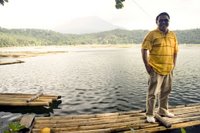 The effort was most worth it as we were rewarded with a spectacular view surrounded by the charm of a traditional fishing community. What a way to cap another day of pleasant surprises.
The effort was most worth it as we were rewarded with a spectacular view surrounded by the charm of a traditional fishing community. What a way to cap another day of pleasant surprises.
 The rivers in Metro Manila are so polluted, river cruises are no longer enjoyable no thanks to the stench. I envy other countries which have river cruises showcasing the skylines, heritage and culture of their capital cities. I guess for now, while government tries to clean up the Pasig and other major rivers in Manila, the second best option is visiting nearby rivers. And few people know that just a few minutes drive north of Manila is one of the country's most important rivers before the arrival of the Spaniards.
The rivers in Metro Manila are so polluted, river cruises are no longer enjoyable no thanks to the stench. I envy other countries which have river cruises showcasing the skylines, heritage and culture of their capital cities. I guess for now, while government tries to clean up the Pasig and other major rivers in Manila, the second best option is visiting nearby rivers. And few people know that just a few minutes drive north of Manila is one of the country's most important rivers before the arrival of the Spaniards. The Rio Grande de Pampanga or Pampanga River for short, was a major thoroughfare before roads were constructed and host to major prehistoric settlements along its pampangs. Hence the name Pampanga. It's source is somewhere in the mountains of Nueva Ecija, flowing down to the Pampanga towns of Arayat, Candaba, San Luis, San Simon, Apalit, Macabebe and Masantol at the mouth of Manila Bay.In the genteel and once elegant barrio of Sulipan in Apalit, there is a boat yard which rents out boats of different sizes from kayaks to two-story air-conditioned house boats for various purposes such as rest and recreation, sight-seeing and birdwatching or sports such as angling and kayaking.
The Rio Grande de Pampanga or Pampanga River for short, was a major thoroughfare before roads were constructed and host to major prehistoric settlements along its pampangs. Hence the name Pampanga. It's source is somewhere in the mountains of Nueva Ecija, flowing down to the Pampanga towns of Arayat, Candaba, San Luis, San Simon, Apalit, Macabebe and Masantol at the mouth of Manila Bay.In the genteel and once elegant barrio of Sulipan in Apalit, there is a boat yard which rents out boats of different sizes from kayaks to two-story air-conditioned house boats for various purposes such as rest and recreation, sight-seeing and birdwatching or sports such as angling and kayaking. 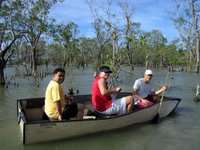 I've personally taken their boats twice. The first was during an exploration and research cruise with the Center for Kapampangan Studies. The second was with my brod Mark Jomalesa and members of the UP Maroons who were looking for an out-of-town nature trip close to Manila. Although I've cruised along the Pampanga River before that during the Apo Iro Fluvial Processions every June.
I've personally taken their boats twice. The first was during an exploration and research cruise with the Center for Kapampangan Studies. The second was with my brod Mark Jomalesa and members of the UP Maroons who were looking for an out-of-town nature trip close to Manila. Although I've cruised along the Pampanga River before that during the Apo Iro Fluvial Processions every June.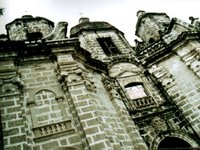 The usual starting point is from their boat yard in Sulipan. But you could make arrangements for them to pick you up in Manila. Heritage stops along the river include the churches of San Luis and Apalit. I really do suggest you stop over since both churches have ceiling murals worth visiting and are very much intact. I hope the parish priests keep them that way.
The usual starting point is from their boat yard in Sulipan. But you could make arrangements for them to pick you up in Manila. Heritage stops along the river include the churches of San Luis and Apalit. I really do suggest you stop over since both churches have ceiling murals worth visiting and are very much intact. I hope the parish priests keep them that way.
 You could also take a detour in Candaba and visit the Candaba Bird Sanctuary which is host to migratory birds. The cruise itself is quite relaxing, perfect for an afternoon nap especially if you are taking a house boat which has lounge chairs on the second floor.
You could also take a detour in Candaba and visit the Candaba Bird Sanctuary which is host to migratory birds. The cruise itself is quite relaxing, perfect for an afternoon nap especially if you are taking a house boat which has lounge chairs on the second floor.
 One of the secrets of Pampanga are found along the shores of Manila Bay. These are the mangroves of Masantol where the water is quite shallow, perfect for kayaking and birdwatching. The photos here are from a February 2004 cruise with Mark Jomalesa, Marvin Cruz and Kenneth Robin. As I've said, I have a lot of archived photos which are worth featuring in this blog.
One of the secrets of Pampanga are found along the shores of Manila Bay. These are the mangroves of Masantol where the water is quite shallow, perfect for kayaking and birdwatching. The photos here are from a February 2004 cruise with Mark Jomalesa, Marvin Cruz and Kenneth Robin. As I've said, I have a lot of archived photos which are worth featuring in this blog.
 The best part of the cruise is watching the renowned Manila Bay sunset from a different place, far from the hustle and bustle of Metro Manila. As the boat speeds back to Apalit and civilization, the Philippine sun colors the sky with a dappled palette, a perfect close to a relaxing day with nature.
The best part of the cruise is watching the renowned Manila Bay sunset from a different place, far from the hustle and bustle of Metro Manila. As the boat speeds back to Apalit and civilization, the Philippine sun colors the sky with a dappled palette, a perfect close to a relaxing day with nature.
 For more information about this cruise and other destinations in Pampanga, you can contact the Center for Kapampangan Studies at (045) 888-8691 loc. 1311 which could link you to the said boat yard.
For more information about this cruise and other destinations in Pampanga, you can contact the Center for Kapampangan Studies at (045) 888-8691 loc. 1311 which could link you to the said boat yard.
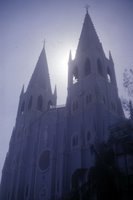 When we say Quiapo, the first things that come to mind are images of the Black Nazarene, the multitude of people that makes an annual walk of fate with the image during the 9th of January processions, and the Basilica Minore of the Black Nazarene (Quiapo Church) with the myriad of hawkers and stalls, herbal medicine and anting-anting vendors and fortune tellers abundant in adjacent Plaza Miranda. But unknown to many, Quiapo is home to an even rarer gem, another basilica minore in fact in Plaza del Carmen. This is the Basilica Minore de San Sebastian, the first all-steel church in the Philippines and in Asia, and the second in the world.I was looking through my archive of photos which I took long before I started to blog. In fact, several were taken even before I enjoyed internet access. And among them were photos of the San Sebastian Church which I shot way back in high school during an alternative class day exposure trip to old Manila. I realized that my photo archive was a wealth of untapped material and not featuring these places I've been to and documented would be a waste.
When we say Quiapo, the first things that come to mind are images of the Black Nazarene, the multitude of people that makes an annual walk of fate with the image during the 9th of January processions, and the Basilica Minore of the Black Nazarene (Quiapo Church) with the myriad of hawkers and stalls, herbal medicine and anting-anting vendors and fortune tellers abundant in adjacent Plaza Miranda. But unknown to many, Quiapo is home to an even rarer gem, another basilica minore in fact in Plaza del Carmen. This is the Basilica Minore de San Sebastian, the first all-steel church in the Philippines and in Asia, and the second in the world.I was looking through my archive of photos which I took long before I started to blog. In fact, several were taken even before I enjoyed internet access. And among them were photos of the San Sebastian Church which I shot way back in high school during an alternative class day exposure trip to old Manila. I realized that my photo archive was a wealth of untapped material and not featuring these places I've been to and documented would be a waste.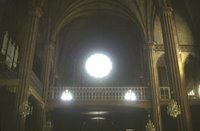 It was sometime in 1995 or 1996, my third year in the Ateneo and we were the beneficiaries of the first-ever alternative class day called KLIK... Klaseng Ibang Klase. We had a choice of selecting three talks throughout the day or pick a day trip for a fee. And I chose this trip to old Manila, with social studies teacher Estela Banasihan and Fr. Mac Reyes, S.J. as tour guides. I consider this trip my introduction to Philippine architectural heritage. The trip tickled my fancy in fact that the next year, I chose another heritage tour during KLIK, a church tour in Rizal and Laguna.
It was sometime in 1995 or 1996, my third year in the Ateneo and we were the beneficiaries of the first-ever alternative class day called KLIK... Klaseng Ibang Klase. We had a choice of selecting three talks throughout the day or pick a day trip for a fee. And I chose this trip to old Manila, with social studies teacher Estela Banasihan and Fr. Mac Reyes, S.J. as tour guides. I consider this trip my introduction to Philippine architectural heritage. The trip tickled my fancy in fact that the next year, I chose another heritage tour during KLIK, a church tour in Rizal and Laguna.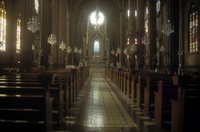 One of our stops was the San Sebastian Church. And to tell you honestly, I was not ready for what I was going to see. Upon entering, this young high school student never realized that such a treasure existed in the country. And I remember distinctly Fr. Mac knocking on the walls of the church to prove to us that the structure was indeed made of steel!
One of our stops was the San Sebastian Church. And to tell you honestly, I was not ready for what I was going to see. Upon entering, this young high school student never realized that such a treasure existed in the country. And I remember distinctly Fr. Mac knocking on the walls of the church to prove to us that the structure was indeed made of steel!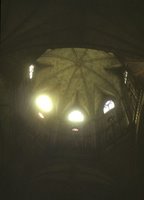 I would later find out that the Philippines used to have much more than that. But the very structures which made us the Pearl of the Orient, architectural treasures that spanned hundreds of years, were flattened by the American Army in a few days during the liberation of Manila.The structure was prefabricated in Belgium, dismantled and shipped back to the Philippines. It was said that after three earthquakes that leveled the earlier San Sebastian churches, the Recollects decided to use an unconventional material to build an earthquake proof church. Which explains why the structure is entirely made of steel. But nothing is decay-free and we all know that the biggest enemy of steel is iron oxide, more commonly known as rust!
I would later find out that the Philippines used to have much more than that. But the very structures which made us the Pearl of the Orient, architectural treasures that spanned hundreds of years, were flattened by the American Army in a few days during the liberation of Manila.The structure was prefabricated in Belgium, dismantled and shipped back to the Philippines. It was said that after three earthquakes that leveled the earlier San Sebastian churches, the Recollects decided to use an unconventional material to build an earthquake proof church. Which explains why the structure is entirely made of steel. But nothing is decay-free and we all know that the biggest enemy of steel is iron oxide, more commonly known as rust!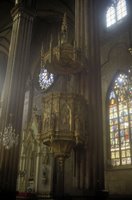
 This is why the World Monuments Fund (WMF) included the structure in the List of 100 Most Endangered Sites in 1998. Inclusion in the World Monuments Watch entitles the structure to grants for restoration. And I find it stupid that the custodians of the church rejected the $25,000 grant given by the WMF simply because of jurisdiction issues with the Philippine government. As a result, the Philippines had to do the embarrassing act of returning the $25,000 to the WMF!It reminds me of the lack of appreciation for heritage rampant in the Catholic Church. In fact, priests are the number one destroyers of Philippine church heritage. They sell off antiques to raise money, lured by heavenly sums offered by sneaky antique collectors. A big number renovate their heritage churches according to their whims and caprices simply to leave their mark, damaging or even eradicating centuries of work in a few months. Right at this very moment, the hard-headed parish priest in Paoay, a UNESCO World Heritage site, is plastering the walls of the church with cement! When will this carnage to heritage churches end? Will the CBCP please put its foot down and end this wanton disregard for Philippine architectural heritage. In Mexico, after their own revolution against Spain, all church property became state property which is why all their churches are untouched and well-preserved. Sometimes, I wished that happened in the Philippines as well.Back to San Sebastian, rumor has it that the metal structure of the San Sebastian Church was designed by Alexander Gustave Eiffel himself. But I have yet to hear the official word from the NHI or NCCA.Metro Manila is host to more heritage churches or what's left of them. You can check out the Visita Iglesia Manila Project for a complete listing.
This is why the World Monuments Fund (WMF) included the structure in the List of 100 Most Endangered Sites in 1998. Inclusion in the World Monuments Watch entitles the structure to grants for restoration. And I find it stupid that the custodians of the church rejected the $25,000 grant given by the WMF simply because of jurisdiction issues with the Philippine government. As a result, the Philippines had to do the embarrassing act of returning the $25,000 to the WMF!It reminds me of the lack of appreciation for heritage rampant in the Catholic Church. In fact, priests are the number one destroyers of Philippine church heritage. They sell off antiques to raise money, lured by heavenly sums offered by sneaky antique collectors. A big number renovate their heritage churches according to their whims and caprices simply to leave their mark, damaging or even eradicating centuries of work in a few months. Right at this very moment, the hard-headed parish priest in Paoay, a UNESCO World Heritage site, is plastering the walls of the church with cement! When will this carnage to heritage churches end? Will the CBCP please put its foot down and end this wanton disregard for Philippine architectural heritage. In Mexico, after their own revolution against Spain, all church property became state property which is why all their churches are untouched and well-preserved. Sometimes, I wished that happened in the Philippines as well.Back to San Sebastian, rumor has it that the metal structure of the San Sebastian Church was designed by Alexander Gustave Eiffel himself. But I have yet to hear the official word from the NHI or NCCA.Metro Manila is host to more heritage churches or what's left of them. You can check out the Visita Iglesia Manila Project for a complete listing.
After that blunder by some local government officials from Batanes last year, we will have to wait again another year until a new Philippine site is listed in the UNESCO World Heritage list. They thought they could handle the inscription process on their own, purposely left out all the experts who prepared the bid of the Batanes Protected Landscapes and Seascapes, and got a painful rejection from UNESCO. What were they thinking? It turns out, the papers were simply not in order and had they included the heritage people involved in documenting Batanes, it would have been listed with UNESCO last year. Sad part is there is a limit to the number of sites listed per country per round. And because of Batanes' deferment, the slot meant for another Philippine site in the next round will be used by Batanes. Oh well!  I chanced upon a list of proposed UNESCO World Heritage sites. I've always known that Batanes is the next Philippine site for inscription in the prestigious list. There are more candidates on the shortlist and it may take several years before we get them in the UNESCO list. Sad to say, I've only visited one of the proposed sites, the San Sebastian Church which I will talk about in my next entry. But I wonder which churches will be included in the listing Jesuit Churches of the Philippines and and which forts in Spanish Colonial Fortifications of the Philippines since I may have seen some of them. Let me try to ask Fr. Rene Javellana since those groupings are actually books which he had written, namely "Wood and Stone for God's Greater Glory: Jesuit Art and Architecture in the Philippines" and "Fortress of Empire: Spanish Colonial Fortifications of the Philippines 1565-1898."
I chanced upon a list of proposed UNESCO World Heritage sites. I've always known that Batanes is the next Philippine site for inscription in the prestigious list. There are more candidates on the shortlist and it may take several years before we get them in the UNESCO list. Sad to say, I've only visited one of the proposed sites, the San Sebastian Church which I will talk about in my next entry. But I wonder which churches will be included in the listing Jesuit Churches of the Philippines and and which forts in Spanish Colonial Fortifications of the Philippines since I may have seen some of them. Let me try to ask Fr. Rene Javellana since those groupings are actually books which he had written, namely "Wood and Stone for God's Greater Glory: Jesuit Art and Architecture in the Philippines" and "Fortress of Empire: Spanish Colonial Fortifications of the Philippines 1565-1898."  Another proposed site are the Angono Petroglyphs were declared a national cultural treasure under Presidential Decree No. 260 of President Marcos in 1973. Together with the San Sebastian Church, both sites were included in the biennial World Monuments Watch: List of 100 Most Endangered Sites in 1996 and 1998 respectively. Most of the sites are featured in the book "The National Parks and Other Wild Places of the Philippines," which came out during the term of Gemma Cruz-Araneta as DOT Secretary. These are Batanes, Mt. Pulag National Park (at 9, 586 feet, Mt. Pulag is the highest peak in Luzon) and Northern Sierra Madre Natural Park in Luzon, the El Nido Marine Reserve, and the Agusan Marsh Wildlife Sanctuary in Mindanao which is one of four Philippine sites listed in the RAMSAR List of Wetlands of International Importance. The tenth site listed is the Turtle Islands Wildlife Sanctuary in Tawi-tawi. Composed of six islands in the Sulu Sea, the marine park is part of a transnational protected area together with Malaysia that is believed to be the only remaining nesting islands for Green Turtles in the ASEAN region.
Another proposed site are the Angono Petroglyphs were declared a national cultural treasure under Presidential Decree No. 260 of President Marcos in 1973. Together with the San Sebastian Church, both sites were included in the biennial World Monuments Watch: List of 100 Most Endangered Sites in 1996 and 1998 respectively. Most of the sites are featured in the book "The National Parks and Other Wild Places of the Philippines," which came out during the term of Gemma Cruz-Araneta as DOT Secretary. These are Batanes, Mt. Pulag National Park (at 9, 586 feet, Mt. Pulag is the highest peak in Luzon) and Northern Sierra Madre Natural Park in Luzon, the El Nido Marine Reserve, and the Agusan Marsh Wildlife Sanctuary in Mindanao which is one of four Philippine sites listed in the RAMSAR List of Wetlands of International Importance. The tenth site listed is the Turtle Islands Wildlife Sanctuary in Tawi-tawi. Composed of six islands in the Sulu Sea, the marine park is part of a transnational protected area together with Malaysia that is believed to be the only remaining nesting islands for Green Turtles in the ASEAN region.  Another proposed listing which I've been hearing about but not found in the tentative list are the Spanish Lighthouses of the Philippines, many of which are featured in the book of Arch. Manolo Noche entitled "Lonely Sentinels of the Sea: The Spanish Colonial Lighthouses in the Philippines." I guess the Philippines has a long way to go in raising the consciousness of its citizens on the importance of preserving heritage. But what can we expect from a Third World country which obviously has more pressing needs? That is why heritage conservationists have to be vigilant in protecting what is left of our built heritage resources. Because when the time comes that Filipinos are mature enough to realize why heritage needs to be protected, there might not be much of it left to appreciate.
Another proposed listing which I've been hearing about but not found in the tentative list are the Spanish Lighthouses of the Philippines, many of which are featured in the book of Arch. Manolo Noche entitled "Lonely Sentinels of the Sea: The Spanish Colonial Lighthouses in the Philippines." I guess the Philippines has a long way to go in raising the consciousness of its citizens on the importance of preserving heritage. But what can we expect from a Third World country which obviously has more pressing needs? That is why heritage conservationists have to be vigilant in protecting what is left of our built heritage resources. Because when the time comes that Filipinos are mature enough to realize why heritage needs to be protected, there might not be much of it left to appreciate.
I'll definitely be blogging quite more often now that I'm done with my MBA. I just came from a business trip to Pangasinan last Sunday. While checking out some properties in Rosales, my brod Ryan Tan mentioned to me that Li-an Ramos (my kabarkada, blockmate in the UP School of Economics and co-dormer at the Kalayaan Residence Hall way back in 1997) was crowned Binibining Pilipinas Universe 2006! Wow! It seemed like only yesterday when we were freshmen at UP. Since we had the same class schedule, and stayed at the same dorm, we often walked to and from the dorm together. Good luck in the Miss Universe pageant in Vanuatu! I'm sure you will take home the crown!Anyway, we had lunch at Matutina's Seafood Restaurant in Bonoan, Dagupan City managed by the Balingit family which finds its roots in the culinary capital of the Philippines... Pampanga. It's a great beach front restaurant frequented by GMA. Sad to say, the beach area in Bonoan is not well-maintained and badly-planned. It was a chopsuey government, judicial, civic and tourist center with a jail on one end of the road and a cemetery and garbage dump on the other end. Along the road are restaurants, a Masonic lodge, the Bangko Sentral ng Pilipinas, the Hall of Justice and a Muslim community among others. And the whole stretch of the road is connected to various beach resorts and rest houses. Talk about urban planning.
 On the way back, we heard Mass in Manaoag. Finally, I was able to visit the miraculous image for the first time! Located 205 kilometers north of Manila, the Church of Manaoag is a major pilgrimage center of the Philippines owing to the popularity of the miraculous image of Our Lady of Manaoag, an image of the Nuestra Señora del Rosario. I remember passing by the old church during the HCS trip to San Fabian but we were not able to stopover. That's it for now.
On the way back, we heard Mass in Manaoag. Finally, I was able to visit the miraculous image for the first time! Located 205 kilometers north of Manila, the Church of Manaoag is a major pilgrimage center of the Philippines owing to the popularity of the miraculous image of Our Lady of Manaoag, an image of the Nuestra Señora del Rosario. I remember passing by the old church during the HCS trip to San Fabian but we were not able to stopover. That's it for now.
 I'm not talking about bacon, lettuce and tomato. If you've heard about that bus company with the acronym BLTB Co. and know what it stands for, then you know where I was this time around. Hehe! Yup, it was another round of Batangas, Laguna and Quezon Province (Tayabas). The main destination was another heritage town which I've been wanting to visit since my trip to Sariaya, Quezon last year.
I'm not talking about bacon, lettuce and tomato. If you've heard about that bus company with the acronym BLTB Co. and know what it stands for, then you know where I was this time around. Hehe! Yup, it was another round of Batangas, Laguna and Quezon Province (Tayabas). The main destination was another heritage town which I've been wanting to visit since my trip to Sariaya, Quezon last year. We left Manila after rush hour for what was to be a quick leisurely drive to Batangas. We were quite surprised we were in Sto. Tomas, Batangas in no time, which is the entry point of the STAR Tollway to Lipa City. I hope they make more of these roads in the provinces since passing by town poblacions is just too frustrating no thanks to the tricycles.
We left Manila after rush hour for what was to be a quick leisurely drive to Batangas. We were quite surprised we were in Sto. Tomas, Batangas in no time, which is the entry point of the STAR Tollway to Lipa City. I hope they make more of these roads in the provinces since passing by town poblacions is just too frustrating no thanks to the tricycles. Before proceeding to San Juan, we decided to make a stopover at the San Sebastian Cathedral, the seat of the Archdiocese of Lipa. The Romanesque church was completed in 1865 but just like much, if not most of our architectural heritage, it was devastated during the war with the current cathedral a result of massive reconstruction and restoration. What attracted me to the cathedral were photos of its wall and ceiling murals. But upon entering, I was quite disappointed.
Before proceeding to San Juan, we decided to make a stopover at the San Sebastian Cathedral, the seat of the Archdiocese of Lipa. The Romanesque church was completed in 1865 but just like much, if not most of our architectural heritage, it was devastated during the war with the current cathedral a result of massive reconstruction and restoration. What attracted me to the cathedral were photos of its wall and ceiling murals. But upon entering, I was quite disappointed.
 With that done, it was off to San Juan. We arrived just in time for lunch. So after a short familiarization drive around, we looked for a place to eat. And since the summer heat was getting to be unbearable, we looked for the first air-conditioned restaurant we could find. I think the place we ate at was the only one in the poblacion... hehehe!
With that done, it was off to San Juan. We arrived just in time for lunch. So after a short familiarization drive around, we looked for a place to eat. And since the summer heat was getting to be unbearable, we looked for the first air-conditioned restaurant we could find. I think the place we ate at was the only one in the poblacion... hehehe!
 The houses are scattered around the town. But it was obvious that the San Juan mark was fast disappearing due to modernization, possibly evolving into another nondescript Filipino town. Unlike Sariaya which has its town character quite intact, modern structures sprout like mushrooms in between heritage houses, obviously out of place. If San Juan is indeed serious in maximizing its heritage potential, it should enact a local ordinance that would regulate the scale and facades of new structures, similar to what we've done in the City of San Fernando. If we only had that much heritage in San Fernando intact! But we lost a lot in the Philippine-American War, WWII and the floods that hit Pampanga after the Mt. Pinatubo eruption. In fact, the chalets in our American quarter are half-buried after the roads were raised by at least a meter.
The houses are scattered around the town. But it was obvious that the San Juan mark was fast disappearing due to modernization, possibly evolving into another nondescript Filipino town. Unlike Sariaya which has its town character quite intact, modern structures sprout like mushrooms in between heritage houses, obviously out of place. If San Juan is indeed serious in maximizing its heritage potential, it should enact a local ordinance that would regulate the scale and facades of new structures, similar to what we've done in the City of San Fernando. If we only had that much heritage in San Fernando intact! But we lost a lot in the Philippine-American War, WWII and the floods that hit Pampanga after the Mt. Pinatubo eruption. In fact, the chalets in our American quarter are half-buried after the roads were raised by at least a meter. Of course, the most prominent of the lakes is Sampalok. At 104 hectares, it is the biggest of the seven lakes and located in the city proper. It was the first lake we visited. The view of Mount Banahaw as a backdrop to the lake was just awesome. But we were in the mood for adventure so we asked around how to get to the others. Since we didn't have time to visit all, we asked for the best one, regardless of distance. And according to those we asked, it was Calibato Lake in Barangay Sto. Angel, which was at the boundary with the town of Rizal, Laguna.
Of course, the most prominent of the lakes is Sampalok. At 104 hectares, it is the biggest of the seven lakes and located in the city proper. It was the first lake we visited. The view of Mount Banahaw as a backdrop to the lake was just awesome. But we were in the mood for adventure so we asked around how to get to the others. Since we didn't have time to visit all, we asked for the best one, regardless of distance. And according to those we asked, it was Calibato Lake in Barangay Sto. Angel, which was at the boundary with the town of Rizal, Laguna. On the way they, we passed by Palakpakin Lake in Barangay San Buenaventura. It has an area of 43 hectares, and looks similar to Sampalok. This time, there were lesser signs of progress and thus, a better view of Banahaw. We took shots from a bridge and moved on to our final destination, Calibato.
On the way they, we passed by Palakpakin Lake in Barangay San Buenaventura. It has an area of 43 hectares, and looks similar to Sampalok. This time, there were lesser signs of progress and thus, a better view of Banahaw. We took shots from a bridge and moved on to our final destination, Calibato. It was difficult looking for Calibato since it was not along the road and you had to hike a bit to get there. After asking around, we finally found the point from where to start the hike down to the 42-hectare crater lake. We didn't know what to expect or how far the lake was from where we parked. Just looking at the downward steps made us imagine the effort it would entail to get back up. Pant! Pant! Hehe! But as we neared the lake, the narrow canyon carved by the small stream increased the level of excitement. I hope we are able to preserve what is left of nature here in the county.
It was difficult looking for Calibato since it was not along the road and you had to hike a bit to get there. After asking around, we finally found the point from where to start the hike down to the 42-hectare crater lake. We didn't know what to expect or how far the lake was from where we parked. Just looking at the downward steps made us imagine the effort it would entail to get back up. Pant! Pant! Hehe! But as we neared the lake, the narrow canyon carved by the small stream increased the level of excitement. I hope we are able to preserve what is left of nature here in the county. The effort was most worth it as we were rewarded with a spectacular view surrounded by the charm of a traditional fishing community. What a way to cap another day of pleasant surprises.
The effort was most worth it as we were rewarded with a spectacular view surrounded by the charm of a traditional fishing community. What a way to cap another day of pleasant surprises.

















